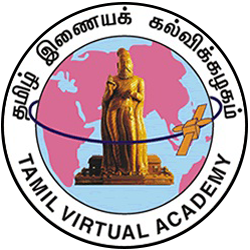This
lesson discusses the various aspects of ‘Thakkayaagap Parani’, one
of the most famous literary texts pertaining to Parani Ilakkiyam.
‘Parani’ is one of the 96 minor literary genres collectively known
as ‘Sittrilakkiyam’ in Tamil. The earliest examples of Parani Ilakkiyam
are traced to the 11th century A.D.
‘Kalingathup Parani’, ‘Thakkayaagap Parani’,
Iranyavathaip Parani’, Kanjavathaip Parani’ and ‘Mohavathaip Parani’
are some popular Parani texts. A Parani celebrates the valour and
heroism of a King or a soldier who has won a great battle after
slaying a 1000 elephants. An interesting feature of Parani is, that
it is named not after the victorious, but after the vanquished or
the place of the battle.
‘Thakkayaagap Parani’ was composed by Ottakkoothar,
a renowned poet of the 12th century A.D. A celebrated court poet
of the Chola kingdom, Ottakkoothar wrote ‘Thakkayaaagap Parani’
at the behest of the Chola King Raja Rajan II.
‘Thakkayaagap Parani’ sings the praise of
Lord Shiva, also hailed as Lord Veera Badra. It recounts an ancient
purana associated with the cult of Lord Shiva. The protagonist or
‘Paattudaithalaivan’ is Lord Shiva. Goddess Parvathi is his consort.
As legend has it, Thakkan, the father of Parvathi, once insulted
Lord Shiva by not inviting him to a Yaaga, he was about to perform.
An enraged Shiva, destroyed the Yaaga by slaying Thakkan and the
devas who assisted him. ‘Thakkayaagap Parani’ celebrates this heroic
deed of Lord Shiva.
‘Thakkayaagap Parani’ comprises 815 verses
called ‘thaazhisaigal’. These are set in a metre
called ‘Kural thaazhisai’. The text begins with an invocatory verse
- ie. ‘Kaapu Cheyyul’- dedicated to Lord Vairava in Seerkaazhi.
The various parts of a Parani are called ‘Parani Uruppugal’. There
are 11 Parani Uruppugal in ‘Thakkayaagap Parani’. They are ‘Kadavul
Vaazhthu’, ‘Kadai Thirappu’, ‘Kaadu Paadiyathu’, ‘Deviyai Paadiyathu’,
‘Peygalai Paadiyathu’, ‘Koyilai Paadiyathu’, ‘Pey Muraippaadu’,
‘Kaalikku Kooli Kooriyathu’, ‘Koozh Aduthalum Iduthalum’, ‘Kalamgaattiyathu’
and ‘Vaazhthu’.
‘Thakkayaagap Parani’ is a ‘purap porul’
text, as it deals with one of the major themes pertaining to Puram
poetry, namely war. It contains various aspects of the purat tinai.
This lesson explains two of these aspects - ‘Thumbai Aaaduthal’
and ‘Padai Vazhakku’.
‘Thakkayaagap Parani’ is considered a valuable
resource book for historians as it abounds in historical details
pertaining to the Chola period. Since Ottakkoothar served as the
court poet with 3 successive Chola kings, he records several interesting
facts about their glorious reign. ‘Thakkayaagap Parani’ also alludes
to several puranas
‘Thakkayaagap Parani’ has several literary
merits. Ottakkoothar was popularly known as ‘Kavi Raatchathar’,
on account of his exceptional poetic talents. One finds ample evidence
of his poetic brilliance in this work. ‘Thakkayaagap Parani’ is
noted for its vivid descriptions and arresting figures of speech.
The lesson discusses 2 of the figures of speech used by Ottakkoothar,
namely, ‘Ilporul Uvamai Ani’ and ‘Niral Nirai Ani’. Ottakkothar
often resorted to poetic exaggerations and hyperboles. There are
several examples of Ottakkothar’s fondness for poetic exaggerations
in ‘Thakkayaagap Parani’


